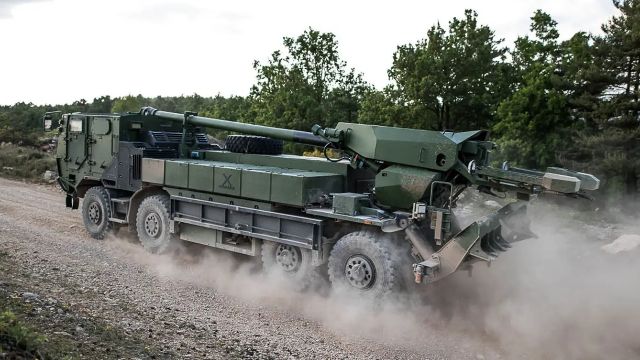Since mid-2023, the 19 CAESAR 8×8 self-propelled howitzers supplied to Ukraine’s Armed Forces have fired over 40,000 rounds, showcasing their critical role in the ongoing conflict with Russia. This is stated in one of the KNDS press releases.

Developed by the French defense company KNDS, these advanced artillery systems, mounted on a robust Tatra 8×8 chassis, have become a cornerstone of Ukraine’s battlefield strategy. Their mobility, precision, and rapid deployment have enabled Ukrainian forces to counter Russian artillery effectively, particularly in high-intensity engagements like those near Bakhmut.
This milestone underscores the growing importance of Western-supplied artillery in bolstering Ukraine’s defense capabilities amid a protracted war. As global attention remains fixed on the conflict’s evolving dynamics, the CAESAR’s performance highlights its strategic significance and the broader geopolitical implications of international military support for Ukraine.
The CAESAR’s role in Ukraine
The CAESAR 8×8, an evolution of the battle-proven CAESAR 6×6 platform, has demonstrated remarkable effectiveness since its delivery to Ukraine in 2023. According to KNDS, the 19 units, primarily provided by Denmark, have collectively fired over 40,000 rounds, averaging approximately 2,100 rounds per system over two years.
This intense usage reflects the system’s durability and Ukraine’s reliance on its “shoot-and-scoot” tactics, which allow rapid firing and relocation to evade Russian counter-battery fire. The howitzer’s 155mm/52-caliber gun, capable of firing NATO-standard rounds up to 40 kilometers and extended-range munitions beyond 50 kilometers, has been pivotal in targeting Russian command posts, artillery batteries, and armored vehicles.
French Defense Minister Sébastien Lecornu emphasized the system’s reliability, noting that CAESAR howitzers have a failure rate one-third lower than comparable Western systems. This resilience, combined with the ATLAS fire control system, enables precise strikes that outmatch many Russian artillery systems, providing Ukraine with a tactical edge in counter-battery operations.
The delivery of these systems, part of a broader French commitment to supply 78 additional CAESARs in 2024, underscores the strategic partnership between France, Ukraine, and allies like Denmark.
A strategic shift in artillery support
The CAESAR 8×8’s deployment in Ukraine marks a significant evolution in Western military aid since Russia’s full-scale invasion in February 2022. Initially, France supplied 18 CAESAR 6×6 units, followed by 12 purchased directly by Ukraine and 19 8×8 variants from Denmark.
These deliveries are part of the “Artillery for Ukraine” coalition, co-led by France and the United States, aimed at enhancing Kyiv’s long-term artillery capabilities. The CAESAR’s lightweight design—32 tons with a Tatra V8 diesel engine—offers superior mobility compared to heavier systems like the German PzH 2000, making it ideal for Ukraine’s dynamic battlefields.
The system’s success builds on its combat-proven history in Afghanistan, Iraq, and Mali, where its rapid deployment and precision were lauded by French forces. In Ukraine, its integration with drones and COBRA radars has amplified its effectiveness, particularly in 2023 operations near Bakhmut, where CAESARs destroyed Russian artillery positions with precision-guided munitions like the Excalibur shell.
This performance has prompted KNDS to quadruple production since 2022, with monthly output rising from two to eight howitzers, and plans to reach 12 by 2025.
Strengthening defense industries
The CAESAR 8×8’s success has significant economic implications for KNDS and its partners. The company’s production ramp-up, with 90% of replacement barrels diverted to Ukraine in 2024, reflects a shift to a “war economy” model.
Each CAESAR, priced at €3-4 million, represents a substantial investment, with France financing 12 of the 78 units pledged for 2024 and seeking €280 million from allies for the remainder. Local production in the Czech Republic, where Excalibur Army handles 40% of the assembly, boosts regional economies and aligns with NATO’s push to modernize Eastern European arsenals.
This surge in demand has spurred KNDS to reorganize production lines, halving delivery times from 30 to 15 months. The CAESAR’s prominence also highlights a broader trend in artillery modernization, prioritizing mobility and precision over heavy armor, as seen in systems like South Korea’s K9 Thunder.
For Ukraine, the economic ripple effect includes sustained maintenance contracts, with regular spare parts orders to support the systems’ intensive use.
The broader artillery landscape
The CAESAR 8×8’s performance in Ukraine has reshaped perceptions of modern artillery, challenging Cold War-era doctrines that favored heavily armored systems. Ukrainian feedback has driven innovations, including AI-enhanced targeting and integration with loitering munitions, addressing threats like drones at ranges up to 40 kilometers.
“The CAESAR’s mobility and precision have redefined artillery’s role in high-intensity conflicts,” said a French defense official, highlighting its adaptability.
However, Ukraine faces a critical challenge: ammunition shortages. Russian forces fire up to 10,000 shells daily, compared to Ukraine’s 2,000, a disparity exacerbated by stalled U.S. aid and slow European deliveries.
France’s commitment to supply 80,000 155mm shells in 2024, up from 30,000 in 2023, aims to close this gap, but Ukraine’s daily requirement of 7,000 shells remains unmet. The CAESAR’s efficiency, firing six rounds per minute, underscores the need for sustained ammunition support to maintain its battlefield impact.
A model for collaboration
The CAESAR program exemplifies international defense cooperation. France’s €50 million contribution to 12 howitzers, combined with Denmark and Ukraine’s direct purchases, demonstrates a shared financial burden.
KNDS’s partnership with the Czech industry, set to begin serial production in June 2025, strengthens NATO’s supply chain and supports local economies. Compared to competitors like the PzH 2000, the CAESAR’s lower cost and air transportability make it an attractive option for nations modernizing their arsenals.
“The CAESAR’s success in Ukraine proves that cost-effective, mobile artillery can rival heavier systems,” said a KNDS spokesperson, emphasizing its market appeal. This model of co-financing and localized production could set a precedent for future defense contracts, particularly as NATO allies seek to counter Russian advances.
Ukraine’s key needs
The CAESAR 8×8’s delivery of over 40,000 rounds since mid-2023 underscores its pivotal role in Ukraine’s defense strategy, blending mobility, precision, and resilience. As France pledges its entire 2025 production to Kyiv, alongside increased shell supplies, the system’s impact extends beyond the battlefield to economic and industrial spheres.
Future deliveries and potential upgrades, like AI integration, promise to enhance Ukraine’s artillery capabilities further. As Sébastien Lecornu noted, “Stronger artillery is one of Ukraine’s key needs to win this war.” The CAESAR’s success signals a new era in artillery warfare, with lasting implications for global defense cooperation.
***
Follow us everywhere and at any time. BulgarianMilitary.com has responsive design and you can open the page from any computer, mobile devices or web browsers. For more up-to-date news, follow our Google News, YouTube, Reddit, LinkedIn, and Twitter pages. Our standards: Manifesto & ethical principles.

